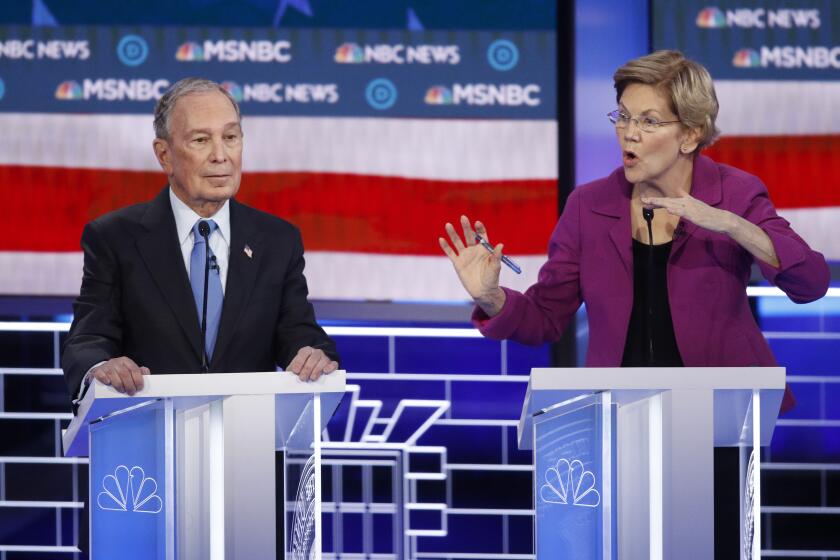Will there be more presidential caucus chaos? ‘Nevada is just praying’
- Share via
LAS VEGAS — Dozens of Democratic volunteers scurried around Doña Maria Mexican Restaurant in polite pandemonium last week as they staged a mock caucus to prepare for the real thing on Saturday in Nevada.
A dining area filled with cries of “Salma Hayek!” “Jennifer Lopez!” “Salma Hayek!” as the volunteers playfully grouped themselves by favorite celebrity rather than by favorite candidate to familiarize themselves with the state’s caucus process.
That was the fun part. But when it came time to actually count votes — not a mere act of addition but a whole range of subtraction, multiplication and division to award delegates — the room fell quiet as participants stared at a whiteboard spreadsheet more than eight columns wide. The complexity of Nevada’s new rules, which now include adding absentee early voters to the mix, had set in.
Democratic officials and campaigns in Nevada are desperately hoping to avoid another caucus meltdown like the one this month in Iowa, where campaigns devoted millions of dollars and deployed hundreds of volunteers in the hopes of emerging as clear winners, only to see the results delayed, misreported and still under challenge of recount.
In recent weeks, the Nevada Democratic Party ditched a new app it had planned to use to report results and trained caucus volunteers on new procedures. Meanwhile, campaigns pressured party officials behind the scenes to release more information about how, exactly, the state planned to avoid a retread of the Iowa fiasco.
“Everybody in Nevada is just praying and focused on not being Iowa,” said Tick Segerblom, a commissioner in Clark County, which includes Las Vegas. “I think we’ve learned our lesson.”
Tom Perez, chairman of the Democratic National Committee, said he was confident the problems would not be repeated in Nevada. “We’ve spent a lot of time going to school on Iowa,” he said Wednesday. Earlier this week, he told the Associated Press he would not commit to releasing results on Saturday.
The glare of the political spotlight — and the scrutiny and stress that come with it — is relatively new for Nevada, which moved up its Democratic caucuses in 2008 to become the third nominating state as part of then-Sen. Harry Reid’s effort to make the Democratic nominating process focus on the Western United States and a more diverse electorate.
Like Iowa, Nevada has had its own problems with the volunteer-run caucus system, where ties are resolved by drawing from a deck of cards.
In 2008, some Nevada Democrats were sent to incorrect caucus locations. In the 2012 Republican contest, it took three days to release results. In 2016, long waits marred the caucuses, some of which did not have federally mandated neutral interpreters, and disabled voters were reportedly unable to participate at some precincts.
Bull’s eye on Bloomberg and Sanders, a fiery Warren, and Klobuchar and Buttigieg get personal
Reforms have been instituted after each cycle, including early voting this year, which has proved popular but has led to long lines. Nearly 75,000 Democrats already voted this month, approaching the total number of people — 84,000 — who participated in the party’s 2016 caucuses.
On Saturday, the preferences on early voters’ ballots will be mixed in with those of traditional caucusgoers, an experimental blend of absentee and in-person democracy that adds complexity to the caucusing process and places a greater burden on the thousands of volunteers who run the caucuses.
Those volunteers were supposed to use a new caucus reporting app, named Shadow, to smooth the process of sending results from caucus sites. But the Nevada state party ditched the app after volunteers in Iowa reported that it wouldn’t let them log in or report results.
The app was part of a cascade of failures in Iowa: A phone line set up as a backup was inundated by calls from trolls. Precinct leaders were stuck on hold for hours as they tried to report results. A paper trail, created as a reform after the 2016 caucuses, revealed errors and inconsistencies in precinct tallies.
Tentative results were not announced for days, and even then, campaigns and journalists challenged their accuracy; the Associated Press said it could not announce a winner. A recanvass of 81 precincts that ended Tuesday brought yet another shift in the state’s tabulations, leading to a recount request from the campaigns of Vermont Sen. Bernie Sanders and former South Bend, Ind., Mayor Pete Buttigieg.
With the Nevada Democratic Party having announced it would not use the Shadow app, officials have had to create a new process in less than three weeks. Campaigns grew increasingly concerned last week about the party’s sluggishness in announcing what that process would look like.
“We’re running out of time, and I’m not sure they have enough people” to tabulate the results on the same day as the caucuses, Nevada congresswoman Dina Titus said last week. Titus, a Democrat who is backing former Vice President Joe Biden in the contest, said campaigns were getting “antsy.”
In recent days, the Nevada state party has revealed details that have assuaged some of the concerns.
Precinct captains will use iPads to enter the number of caucus attendees and their candidate preferences into a precinct-specific form, which will convert the numbers into delegates.
Then, a volunteer will call in the results using a party hot line. (The phone number is being closely guarded.) The Google form also will automatically transmit results to the state party’s master file. There will be a paper record of each caucus result.
Gregory Miller, chief operating officer of the OSET Institute, a nonprofit election technology organization, was among those sounding the alarm about the Nevada caucuses. But he said the plans the state party rolled out had alleviated some of his worries.
“The technological solution that they have gone to is credible and makes sense,” he said. “It’s the best they can do with what they’ve got to work with.”
He said innovating caucus reporting had been an unnecessary bow to the “technorati.” By OSET’s calculations, it cost the state party more than $400,000 to buy the iPads and internet service.
“It’s a solution in search of a problem,” he said.
Carrie Giddins, a former Iowa Democratic Party leader who traveled to Nevada to help run the caucuses in 2008, said she wished Democrats would go back to using tried-and-true methods.
“Part of me wishes we could go back to simple days when phone numbers were more than fine,” said Giddins, now a professor at American University.
The state party and independent groups have tried to train volunteers and caucusgoers to understand the process, and last week’s session at Doña Maria restaurant, using the celebrity “candidates,” showed how complicated things could get.
First, caucus volunteers needed to add ballots from mock early voters — the new, invisible participants in this year’s process — to calculate the overall 15% threshold of support necessary to win delegates.
Then they had to figure out which candidates weren’t viable by combining the preferences of the absentee early voters and the in-person caucusgoers.
Then came realignment; in addition to the usual process of caucusgoers realigning from unpopular candidates to popular candidates, the absentee ballots had to be checked for the early voters’ realignment preferences.
“What’s supposed to happen here is that these are supposed to add up to this,” a volunteer said, pointing to the array of celebrities’ vote totals and then to the sum of early voters and caucus participants on the spreadsheet.
Then she did the math on her phone — and the numbers didn’t add up. Latecomers had arrived and participated without announcing themselves.
“What?” she said, staring at the board. “Four people came into the room!”
California’s primary election is March 3, 2020. Here’s what you need to know about the presidential candidates and voting on Super Tuesday.
More to Read
Get the L.A. Times Politics newsletter
Deeply reported insights into legislation, politics and policy from Sacramento, Washington and beyond. In your inbox twice per week.
You may occasionally receive promotional content from the Los Angeles Times.














